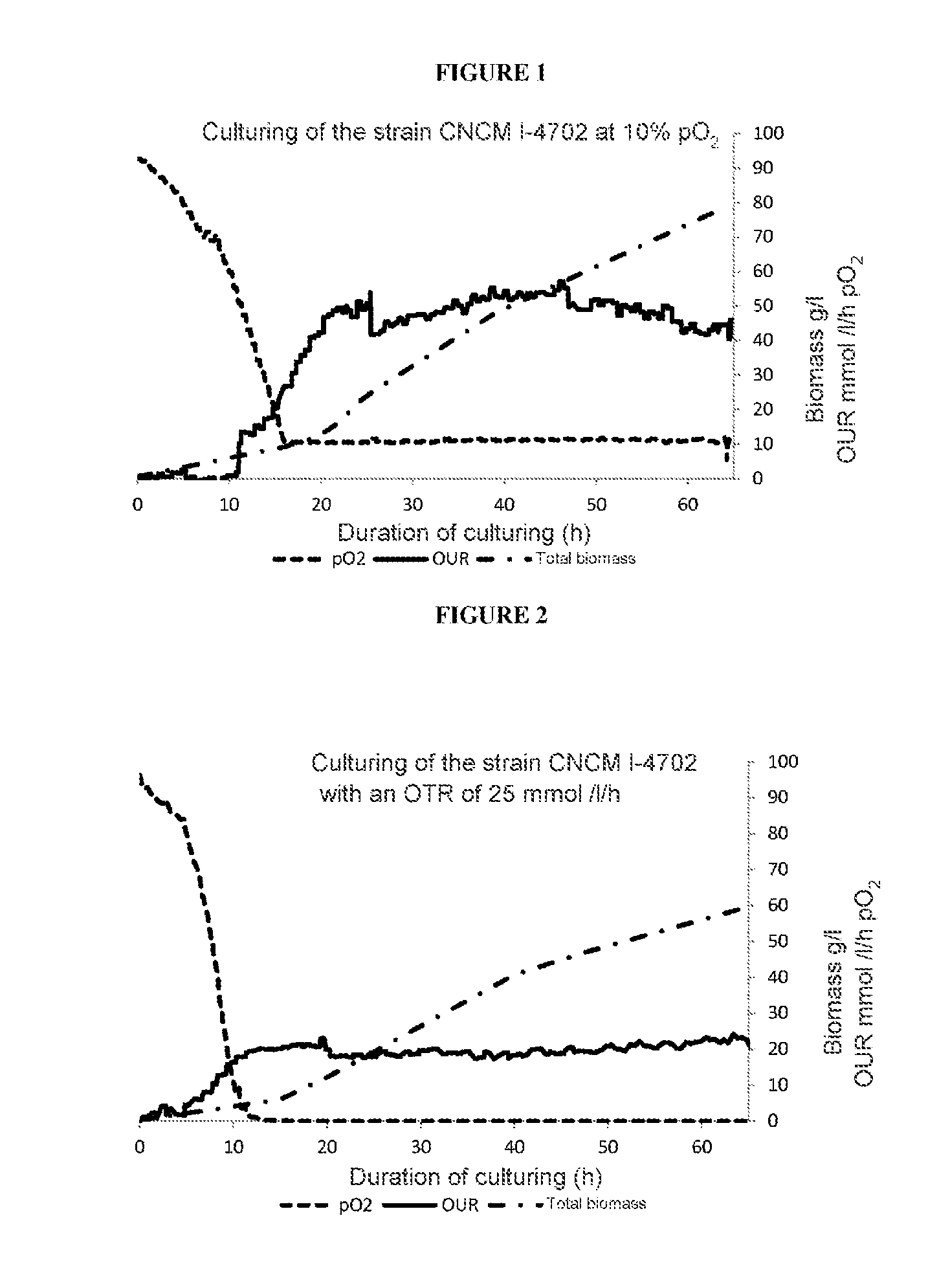Method for enriching the biomass of thraustochytrium genus microalgae with DHA
a technology of thraustochytrium and biomass, applied in the direction of fermentation, unicellular algae, etc., can solve the problems of limiting their growth, unfulfilled need for an alternative method, and conventionally uncoupled growth and production in fermenting methods
- Summary
- Abstract
- Description
- Claims
- Application Information
AI Technical Summary
Benefits of technology
Problems solved by technology
Method used
Image
Examples
example 1
Conditions for Culturing Strains CNCM I-4469 and CNCM I-4702 and Determining the Specific Production Rates in Oxygenation Excess
[0183]Culturing Conditions
[0184]The protocol comprises preculturing in an Erlenmeyer flask for inoculation of the fermenter at 0.1 g of biomass / l for strain CNCM I-4469, and at least 5 g of biomass / l for strain CNCM I-4702.
Preculturing
[0185]Preculturing (100 ml of medium) in a 500 ml baffled Erlenmeyer flask lasts for 24 h at a temperature of 28° C.
[0186]All the components of the medium together are sterilized by filtration and introduced into an Erlenmeyer flask sterilized beforehand in an autoclave after addition of a drop of Clearol FBA 3107 antifoam.
TABLE IIIPreculture medium % (g / g)Anhydrous glucose3Yeast extract0.4Monosodium glutamate6.42NaCl1.25MgSO4 7(H2O)0.4KCl0.05CaCl2 2(H2O)0.01NaHCO30.05KH2PO40.4Stock solution vitamins B1, B6, B120.1Stock solution trace elements0.8
Culturing
[0187]The medium is sterilized in 3 parts.
[0188]The glucose is sterilized...
example 2
Culturing Strains CNCM I-4469 and CNCM I-4702 with a Controlled Oxygen Supply
[0205]The same culturing conditions were used but the oxygen supply was controlled.
[0206]The method consists in using half the observed transfer value (OUR) during culturing at 10% (here: 50 mmol / l / h, cf. graph 1, i.e. 25 mml / l / h) (FIG. 2).
[0207]Moreover, for a 20 l fermenter, to respect the proper operation of the fermenter irrespective of the oxygenation requirements, a minimum stirring of the order of 150 rpm is fixed at t0 for the first 10 to 15 hours of culturing.
[0208]In table IX, the results given are those obtained at T65 of the culturing of the biomasses of the two strains CNCM I-4469 and CNCM I-4702 under conditions of controlled O2 supply.
TABLE IXBiomasses and fatty acid compositionsCNCM I-4469CNCM I-4702Biomass (g / l)3459F.A content / Total biomass (g / g)0.290.45DHA / F.A (g / g)0.520.44Palmitic acid / F.A (g / g)0.040.39Other fatty acids / F.A (g / g)0.440.17
[0209]The average rates are calculated globally as i...
example 3
Fermentation Operation with Different OTR Conditions
[0229]The tests carried out in examples 1 and 2, without limiting nutritional sources, make it possible to create a model by means of which it is possible to control lipid production by respecting a target qO2 defined by equation 2 (which is equal to 27.4 mmol of O2 / I of culture and per h: cf. example 2).
[0230]From this initial target qO2, variations were tested.
[0231]The degrees of variation, on either side of this target qO2, are illustrated here by the max.OTR at the start of culturing.
[0232]The max.OTR value of between 25 and 30 corresponds to the optimum OUR at the start of culturing defined within the context of the invention for controlling the oxygen supply and in order to respect the target qO2.
[0233]Table XI gives the fermentation parameters measured at T65 with CNCM I-4702.
TABLE XIConcentrationsMax. OTRPalmiticDHA% of(mmol / l / h)Fatty acidsacid(g / 100 gtargetat the startBiomass(g / 100 g of(g / 100 g ofofqO2of culturing(g / l)bio...
PUM
 Login to View More
Login to View More Abstract
Description
Claims
Application Information
 Login to View More
Login to View More - R&D
- Intellectual Property
- Life Sciences
- Materials
- Tech Scout
- Unparalleled Data Quality
- Higher Quality Content
- 60% Fewer Hallucinations
Browse by: Latest US Patents, China's latest patents, Technical Efficacy Thesaurus, Application Domain, Technology Topic, Popular Technical Reports.
© 2025 PatSnap. All rights reserved.Legal|Privacy policy|Modern Slavery Act Transparency Statement|Sitemap|About US| Contact US: help@patsnap.com



